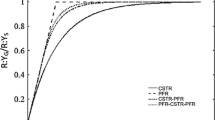Abstract
Models used to employ waste dispersion from sea cages rarely take into account the physical characteristics of fish feed and faeces. In this study we determine the hardness, friability, water absorption properties and settling velocity of a range of commercial Atlantic salmon (Salmo salar L.) feeds, under defined laboratory conditions.
Hardness of large, high energy pellets (≥ 8.5 mm) was generally greater than that of 6 mm high energy pellets. With the exception of 100 mm pellets, the friability of large pellets was also greater than that of the smaller pellets. Settling velocities were significantly greater at 20 psu than at 33 psu and significantly higher for most pellet types at 10 °C than at 20 °C. Settling velocities for unsoaked pellets were found to increase with pellet size, from a mean of 5.6 cm s−1 for the smallest pellet (2 mm) to 13.9 cm s−1 for the 10 mm standard (20 to 24% fat) pellets. The smallest feed pellets (2 mm) had the greatest percentage wet weight increase on immersion, irrespective of salinity. Settling velocities of pellets were not significantly affected by immersion time (0–15 min).
Given the water depths at fish cage sites and the settling times involved, it is concluded that it is unnecessary to take account of changes in food pellet settling velocity as a result of immersion. Effects of pellet size and salinity on settling velocity are best incorporated into waste dispersion models through the use of 'look-up' tables.
Similar content being viewed by others
References
Anderson, J.S., Higgs, D.A., Beams, R.M. and Rowshandeli, M. 1996. The effect of varying the dietary digestible protein to digestible lipid ratio on the growth and whole body composition of Atlantic salmon (Salmo salar) (0.5–1.2 kg) reared in sea water. Canadian Data Report of Fisheries and Aquatic Sciences, 25 pp.
Beveridge, M.C.M. 1996. Cage Aquaculture. 2nd edn 346 pp. Fishing News Books: Oxford.
Beveridge, M.C.M., Phillips, M.J. and Clarke, R.M. 1991. A quantitative and qualitative assessment of wastes from aquatic animal production. In: Advances in World Aquaculture Volume 3, D.E. Brune and J.R. Tomasso (eds), pp. 506–533. World Aquaculture Society, Baton-Rouge, USA.
Beveridge, M.C.M., Phillips, M.J. and Macintosh, D.C. 1997. Aquaculture and the environment: the supply and demand for environmental goods and services by Asian aquaculture and the implications for sustainability. Aquaculture Research 28: 101–111.
Blyth, P.J., Purser, G.J. and Russell, J.F. 1993. Detection of feeding rhythms in sea caged Atlantic salmon using new technology. In: Fish Farming Technology, H. Reinerstsen, L.A. Dahle, L. Joergensen and K. Tvinnereim (eds), pp. 209–216. A.A. Balkema, Rotterdam.
Cho, C.Y. and Bureau, D.P. 1997. Reduction of waste output from salmonid aquaculture through feeds and feeding. Progressive Fish-Culturist 59: 155–160.
Cho, C.Y., Hynes, J.D., Wood, K.R. and Yoshida, H.K. 1994. Development of high-nutrient, low-pollution diets and prediction of aquaculture wastes using biological approaches. Aquaculture 124: 293–305.
Elberizon, I.R. and Kelly, L.A. 1998. Empirical measurements of parameters critical to modeling benthic impacts of freshwater salmonid cage aquaculture. Aquaculture Research 29: 183–195.
Findlay, R.H. and Watling, L. 1994. Towards a process level model to predict the effects of salmon net-pen aquaculture on the benthos. In: Modelling Benthic Impacts of Organic Enrichment from Marine Aquaculture, B.T. Hargrave, (ed.), Canadian Technical Report of Fisheries and Aquatic Society 1949: 47–77.
Gowen, R.J. 1994. Managing eutrophication associated with aquaculture development. Journal of Applied Ichthyology 10: 242–257.
Gowen, R.J. and Bradbury, N.B. 1987. The ecological impact of salmon farming in coastal waters: A review. Oceanographic and Marine Biology: An Annual Review 25: 563–575.
Gowen, R.J., Smyth, D. and Silvert, W. 1994. Modelling the spatial distribution and loading of organic fish farm waste to the sea-bed. In: Modelling Benthic Impacts of Organic Enrichment from Marine Aquaculture, B.T. Hargrave (ed.), Canadian Technical Report of Fisheries and Aquatic Science 1949: 19–30.
Heinen, J.M., Hankins, J.A. and Adler, P.R. 1996. Water quality and waste production in a recirculating trout-culture system with feeding of a higher-energy or a lower-energy diet. Aquaculture Research 27: 699–710.
Hevia, M.G., Rosenthal, H. and Gowen, R.J. 1996. Modelling benthic deposition under fish cages. Journal of Applied Ichthyology 12: 71–74.
Juell, J.E. 1991. Hydroacoustic detection of food waste — a method to estimate maximum food intake of fish populations in sea cages. Aquaculture Engineering 10: 207–217.
Kalle, K. 1971. Salinity. In: Marine Ecology Vol. 1, I.O. Kinne (ed.), pp. 683–688. Wiley Interscience, New York.
Robinson, B.H. and Bailey, T.G. 1981. Sinking rates and dissolution of midwater fish faecal matter. Marine Biology 65: 135–142.
Ryan, B.F. and Joiner, B.L. 1994. Minitab Handbook, third edn, 354 pp. Duxbury Press, Belmont, California.
Silvert, W. 1992. Assessing environmental impacts of finfish aquaculture in marine waters. Aquaculture 107: 67–79.
Silvert, W. 1994. Modelling benthic deposition and impacts of organic matter loading. In: Modelling Benthic Impacts of Organic Enrichment from Marine Aquaculture, B.T. Hargrave (ed.), Canadian Technical Report of Fisheries and Aquatic Science 1949, 1–18.
Smith, I.R. 1975. Turbulence in Lakes and Rivers. Freshwater Biological Association. Scientific Publication No. 29, 79 pp., Cumbria, UK.
Thomas, M. and van der Poel, A.F.B. 1996. Physical quality of pelleted animal feed 1. Criteria for pellet quality. Animal Feed Science Technology 61: 89–112.
Thorpe, J.E., Talbot, C., Miles, M.S., Rawling, C. and Keay, D.S. 1990. Food consumption in 24 hours by Atlantic salmon (Salmo salar L.) in a sea cage. Aquaculture 90: 41–47.
Wood, J.F. 1987. The functional properties of feed raw materials and their effect on the production and quality of feed pellets. Animal Feed Science Technology 61: 89–112.
Wu, R.S.S., Lam, K.S., MacKay, D.W., Lau, T.C. and Yam, V. 1994. Impact of marine fish farming on water quality and bottom sediment: A case study in the sub-tropical environment. Marine Environmental Research 38: 115–145.
Author information
Authors and Affiliations
Corresponding author
Rights and permissions
About this article
Cite this article
Chen, YS., Beveridge, M.C. & Telfer, T.C. Physical Characteristics of Commercial Pelleted Atlantic Salmon Feeds and Consideration of Implications for Modeling of Waste Dispersion through Sedimentation. Aquaculture International 7, 89–100 (1999). https://doi.org/10.1023/A:1009249721787
Issue Date:
DOI: https://doi.org/10.1023/A:1009249721787




